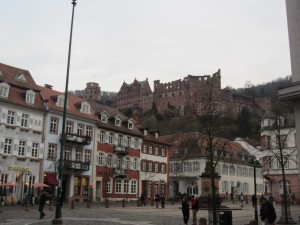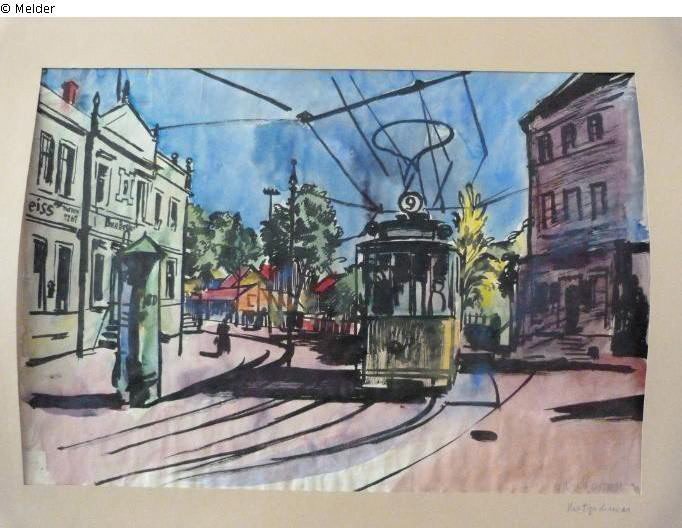As Germany puts on the much-anticipated exhibition in Bonn of Cornelius Gurlitt’s disputed collection, a strange story has developed not too far away in Düsseldorf. The Stadtmuseum, which is administered by the city itself, had organized—but now cancelled—“Max Stern: from Düsseldorf to Montreal.” The exhibition was scheduled to open in February in Düsseldorf, before traveling to the Haifa art museum in September of 2018 and to the McCord Museum in Montreal in 2019. The city’s acknowledgement that the decision was based on a claim for restitution from the Max Stern Estate is a disturbing development that provides no sound reason to cancel a show about an important dealer who, it is undisputed, was a seminal figure of Nazi persecution.
Something’s Rotten in Düsseldorf—Max Stern Exhibition Cancelled in Response to Restitution Claim
Topics: Nuremberg laws, Cologne, Cornelius Gurlitt, Germany, The Art Newspaper, Köln, Nazi-looted art, Düsseldorf, The New York Times, A Tragic Fate, Max Stern from Düsseldorf to Montreal, McCord Museum, Reichskammer der bildenden Künste, Dr. and Mrs. Max Stern Foundation, Max Stern Restitution Project, Girl from the Sabine Mountains, Max Stern, Haifa, Francis Xavier Winterhalter, Mädchen aus den Sabiner Bergen, The Artist’s Children, Wilhelm von Schadow, Düsseldorf Kunstpalast, Andreas Achenbach, Sicilian Landscape, Norwegian Landscape, Galerie Max Stern, Mayor Thomas Geisel
Restitution Claims Resolved in New York and Cologne, New Case Filed Against Germany
Word came this week of two resolutions of claims to Nazi-looted art in museums in New York and Cologne, and a new Nazi-looted claim against Germany filed in Washington. Barely a month after the Neue Galerie (of Austrian and German art) in New York announced that it had discovered a “major work” in its collection had a clouded history, the museum announced an agreement concerning the Karl Schmitt-Rotloff painting Nude (1914). It is not known if the Schmitt-Rotloff is the same work to which the museum referred last month. Around the same time, the Wallraff-Richartz-Museum in Cologne, Germany, announced that it had agreed to return a drawing by Adolf Menzel that had been sold to Hildebrand Gurlitt as its owners fled Nazi Germany in the 1930s. Blick über die Dächer von Schandau (View over the rooves of Schandau) (1886) will be retuned to the heirs of Hamburg attorney Albert Martin Wolffson and his daughter Elsa Helene Cohen. These settlements are examples of constructive dialogue and enlightened treatment of the historical fact. The new litigation likely means the opposite approach from the German defendants.
Topics: Cologne, Schwabinger Kunstfund, Breslau, Gurlitt Task Force, Germany, Wallraf-Richartz Museum, Nazi-looted art, 28 U.S.C. 1605(a)(3), Gurlitt, David Toren, Neue Galerie, Ernst Ludwig Kirchner, New York, Karl Schmitt-Rotloff, Alfred and Tekla Hess, Streen Scene in Berlin, Adolf Menzel, Strassenzene
Cornelius Gurlitt’s Lawyers File Privacy Complaint
In one of the first affirmative steps taken by Cornelius Gurlitt since the revelation of the seizure of a large number of artworks with possible Nazi-seizure connections, Gurlitt has filed a criminal complaint concerning his allegations of violations of his privacy rights. According to Gurlitt’s attorney, “The surrender of investigative information to the press, and with it the severe damage to his personal rights is not tolerable in any way for Mr. Gurlitt. . . . This is a blatant violation of official secrecy.” Another of his lawyers went on to express concern for trust in the process in which details were being given to the media. In particular, Gurlitt’s team were most upset about photographs in the Focus piece that broke the story of Gurlitt’s apartment.
Topics: Stuttgart, Das Alte Schauspielhaus, Cologne, Irina Alter, veschollene Kunst, Schwabinger Kunstfund, Wiedergutmachung, Annette Weber, Hildebrand Gurlitt, Cornelius Gurlitt, Corinna Budras, S. Lane Faison, Universität Heidelberg, Augsburg, Institute for Jewish Studies Heidelberg, Aryanization, Anat Feinberg, Willi Korte, Schwabinger Kunstfund. Kunstfund München, Monuments Man, Gurlitt Task Force, Germany, Fall Gurlitt, Köln, Nazi-looted art, Henry Keazor, Gurlitt Collection, Appropriated Art the Gurlitt Case, Kurpfälzisches Museum Heidelberg, Hochschule für Judische Studien Heidelberg, Eberhard Karls-Universität Tübingen, Emily Löffler, CSU, Williams College, Judische Allgemeine, Hildebrand Gurlit, Entartete Kunst, Universität Zürich, Arisierung, Lehrstuhl für Römisches Recht und Privatrecht, Nürnberger Institut, Rückgabe, Rhein-Neckar Morgenweb, Beutekunst, 'Stürmer-Bibliothek', Magdeburg, Daniel Krochmalnik, Ersessene Kunst, Katja Terlau, Art Loss Recovery Unit, Jim Tobias, Rhein-Neckar Zeitung, Fritz Backhaus, Gurlitt, Bavaria, Johannes Heil, Wien, Sullivan & Worcester LLP, Lucas Elmenhorst, Kunsthistorisches Institut, Nürnberg, Jüdisches Museum Frankfurt, Looted Art, „Sturmer-Library“, degenerate art, Boston, Seminar für Neuere Geschichte, Wolfgang Ernst, www.lostart.de, Nazi art, Raubkunst, Nicholas M. O'Donnell, Frieder Hepp, Verjährung, Vienna, Münchner Kunstfund, New York, FAZ Frankfurt, Felicitas Heiman-Jellinek
Recap of Ersessene Kunst—Der Fall Gurlitt (Appropriated Art—The Gurlitt Case): January 26, 2014 in Heidelberg
I’ve just returned from my presentation in Heidelberg at the Hochschule für Jüdische Studien in Heidelberg at the conference Ersessene Kunst—Der Fall Gurlitt; Appropriated Art—The Gurlitt Case. The presentations were, without exception, outstanding. They ranged from rarely-told case stories, to sharp insights of some of the overarching principles that guide the the Gurlitt case and similar events. As the discussions made clear, this case will not be easily resolved. That in turn makes recent reports that Cornelius Gurlitt has indicated a willingess to discuss the art's return all the more significant.
Topics: Maria Altmann, Leopold Reidemester, Ministerin für Justiz und Kultur, Stuttgart, Das Alte Schauspielhaus, Cologne, Irina Alter, Portrait of Adele Bloch-Bauer, veschollene Kunst, Focus, Schwabinger Kunstfund, Aschbach Castle, Mussolini, Wiedergutmachung, Annette Weber, Monte Cassino, Cornelius Gurlitt, Corinna Budras, S. Lane Faison, Breslau, Universität Heidelberg, Augsburg, Aryanization, Anat Feinberg, Willi Korte, Schwabinger Kunstfund. Kunstfund München, Monuments Man, Jud Süss, Wrocław, Dresden, Gurlitt Task Force, Germany, Silesia, Fall Gurlitt, Wallraf-Richartz Museum, Köln, Nazi-looted art, Henry Keazor, Gurlitt Collection, Appropriated Art the Gurlitt Case, Schloss Aschbach, Die Welt, Kurpfälzische Museum Heidelberg, Hochschule für Judische Studien Heidelberg, Karl Haberstock, Eberhard Karls-Universität Tübingen, Emily Löffler, CSU, Williams College, Hildebrand Gurlit, Entartete Kunst, Universität Zürich, Arisierung, Lehrstuhl für Römisches Recht und Privatrecht, Württemberg, Schlesien, Nürnberger Institut, Hamburg, Otto Förster, Rückgabe, Beutekunst, 'Stürmer-Bibliothek', Magdeburg, Portrait of Amalie Zuckerkandl, Ersessene Kunst, Katja Terlau, Art Loss Recovery Unit, Jim Tobias, Hermitage, Gurlitt, Bavaria, Johannes Heil, Wien, Sullivan & Worcester LLP, Lucas Elmenhorst, Events, Kunsthistorisches Institut, Nürnberg, Jüdisches Museum Frankfurt, Looted Art, „Sturmer-Library“, degenerate art, Seminar für Neuere Geschichte, Wolfgang Ernst, Justizminister, Göring, www.lostart.de, Nazi art, Raubkunst, Nicholas M. O'Donnell, Frieder Hepp, Verjährung, Vienna, Claudius Krausharr, Münchner Kunstfund, Zwickau, Kajetan Mühlmann, New York, Werner Haftmann, FAZ Frankfurt, Felicitas Heiman-Jellinek
“Appropriated Art—the Gurlitt Case,” Heidelberg, Germany January 26, 2014
The Institute for Jewish Studies in Heidelberg (the Hochschule für Judische Studien Heidelberg) will host a one-day conference on January 26, 2014 entitled “Appropriated Art—The Gurlitt Case” (Ersessene Kunst—Der Fall Gurlitt). Leading academics, journalists, and researchers will put the Gurlitt find into a historical and legal perspective. As listed below, the depth of topics that will be presented is outstanding. Last, and very much least, I will present on the efficacy, challenges, and policy considerations in U.S. art restitution litigation.
Topics: Stuttgart, Das Alte Schauspielhaus, Cologne, Irina Alter, Schwabinger Kunstfund, Wiedergutmachung, Annette Weber, Hildebrand Gurlitt, Cornelius Gurlitt, Corinna Budras, Universität Heidelberg, Institute for Jewish Studies Heidelberg, Aryanization, Anat Feinberg, Fall Gurlitt, Köln, Nazi-looted art, Henry Keazor, Gurlitt Collection, Appropriated Art the Gurlitt Case, Kurpfälzische Museum Heidelberg, Hochschule für Judische Studien Heidelberg, Eberhard Karls-Universität Tübingen, Emily Löffler, Entartete Kunst, Universität Zürich, Arisierung, Lehrstuhl für Römisches Recht und Privatrecht, Nürnberger Institut, Rückgabe, Beutekunst, 'Stürmer-Bibliothek', Daniel Krochmalnik, Ersessene Kunst, Katja Terlau, Jim Tobias, Fritz Backhaus, Johannes Heil, Wien, Sullivan & Worcester LLP, Events, Kunsthistorisches Institut, Nürnberg, Jüdisches Museum Frankfurt, Looted Art, „Sturmer-Library“, degenerate art, Boston, Seminar für Neuere Geschichte, Wolfgang Ernst, Raubkunst, Nicholas M. O'Donnell, Frieder Hepp, Vienna, Münchner Kunstfund, New York, FAZ Frankfurt, Felicitas Heiman-Jellinek
Gurlitt Taskforce Announces Plan to Post 590 More Works. Choice of Law, Procedure, and Venue for Claims Up in the Air
Ingeborg Berggreen-Merkel, leader of the newly formed federal “Schwabing Art Find” taskforce, announced plans to release information about 590 additional works found in the apartment of Cornelius Gurlitt, after the posting earlier this week of 25 works at www.lostart.de. Meanwhile, the heirs of Max Ernst have publicly disclosed (through their attorney Jürgen Wilhelm in Cologne) their claim to certain of the works in the Gurlitt find. The federal authorities appear to be gaining the upper hand for disclosure against the tax investigators in Bavaria who initially seized the collection, which was not a foregone conclusion.
Topics: Cologne, veschollene Kunst, the Lion Tamer, Lempertz, Cornelius Gurlitt, Schwabinger Kunstfund. Kunstfund München, Max Liebermann, Köln, Gurlitt Collection, Foreign Sovereign Immunities Act, Hildebrand Gurlit, Entartete Kunst, Nazis, Ingeborg Berggreen-Merkel, Hermann Goring, Michael Hulton, FSIA, Gurlitt, Restitution, conversion, Looted Art, World War II, degenerate art, Altmann v. Republic of Austria, Löwenbändiger, Raubkunst, Alfred Flechteim, Jürgen Wilhelm, Max Ernst
Ruminations on Connoisseurship, Forgery, Knoedler and Litigation in the News
We’ve been following a number of prominent stories for several weeks now and thinking about what they mean in the crossover between art and the law. It’s fair to say that a theme is starting to develop, namely, that after the Beltracchi forgery trial in Cologne, the Warhol Foundation’s decision to close its doors to authentication requests, and the brewing scandal over the authenticity of paintings sold by Knoedler and other galleries, the legal significance of knowing—and even asking—the age-old question from Art History 101—“who made that?”—has come again to the fore.
Topics: Cologne, Forgery, Knoedler, The Art Newspaper, Inc., Degas, Jackson Pollock, catalogue raisonné, Wolfgang Beltracchi, Collections, The Warhol Foundation for the Visual Arts, Georgina Adam, The Art Law Blog, connoisseurship
Beltracchi and Forgers Sentenced in Cologne
The forgery trial in Cologne ended yesterday with the sentencing of Wolfgang Beltracchi and his co-defendants for their now-infamous forgeries and sale of the fictional "Werner Jäger" collection-the name of his wife's grandfather. Beltracchi was sentenced to 6 years, consistent with the deal struck last month with prosecutors, the other defendants (including his wife) to various lesser terms.
Topics: Cologne, Forgery, Germany, Wolfgang Beltracchi, connoisseurship, Max Ernst
German Forgery Trial Update-Deal Offered?
We have been following with interest the trial in Cologne, Germany of four accused forgers. The trial began at the beginning of the month. Wolfgang Beltracchi, 60, is accused of organizing a scam that defrauded art collectors out of millions of dollars. Comedian, actor, and writer Steve Martin is among the most high-profile victims. The 47 forgeries mimicked 20th century paintings by Kees Van Dongen, Max Ernst, Max Pechstein and Heinrich Campendonk.
Topics: Cologne, Forgery, Lempertz, Germany, Wolfgang Beltracchi, Restitution, connoisseurship, Max Ernst





